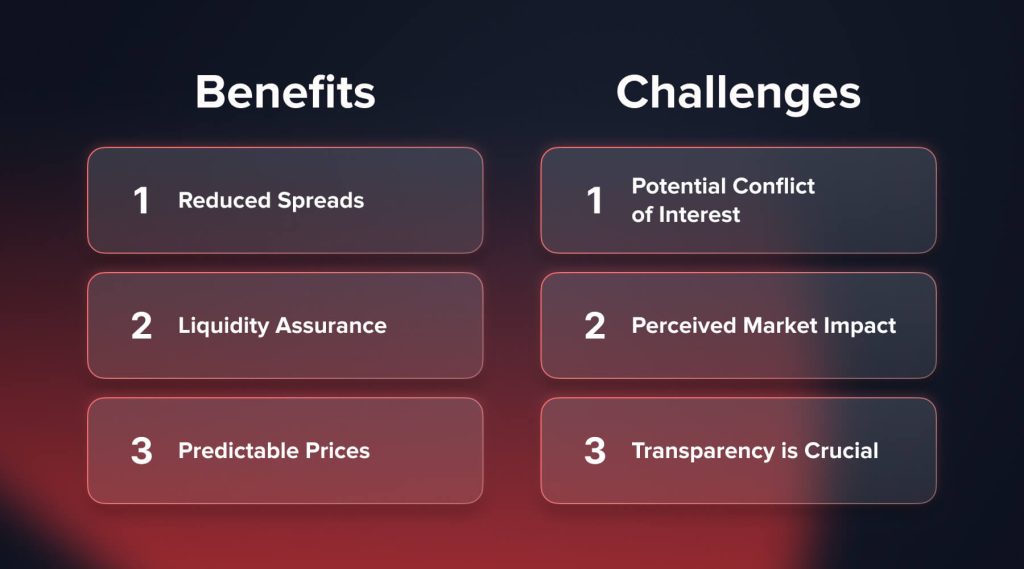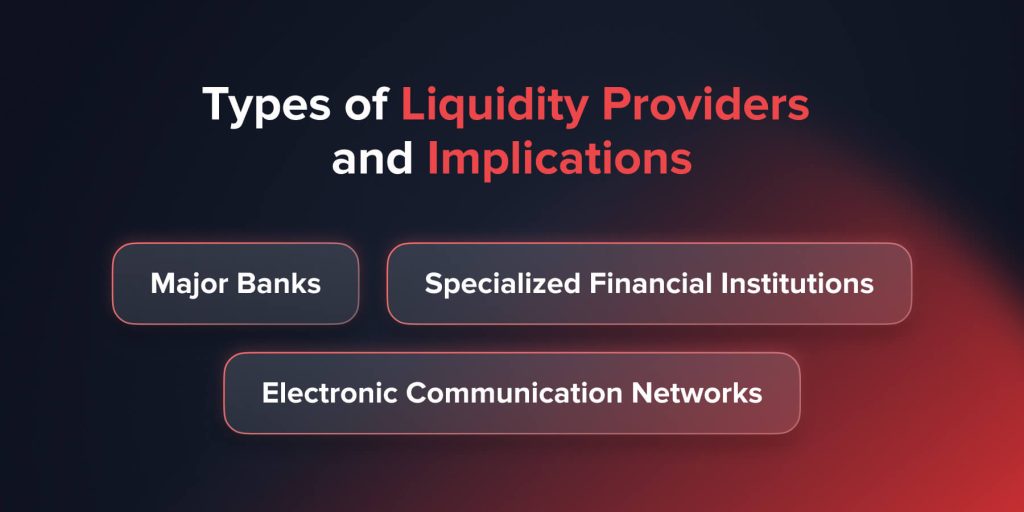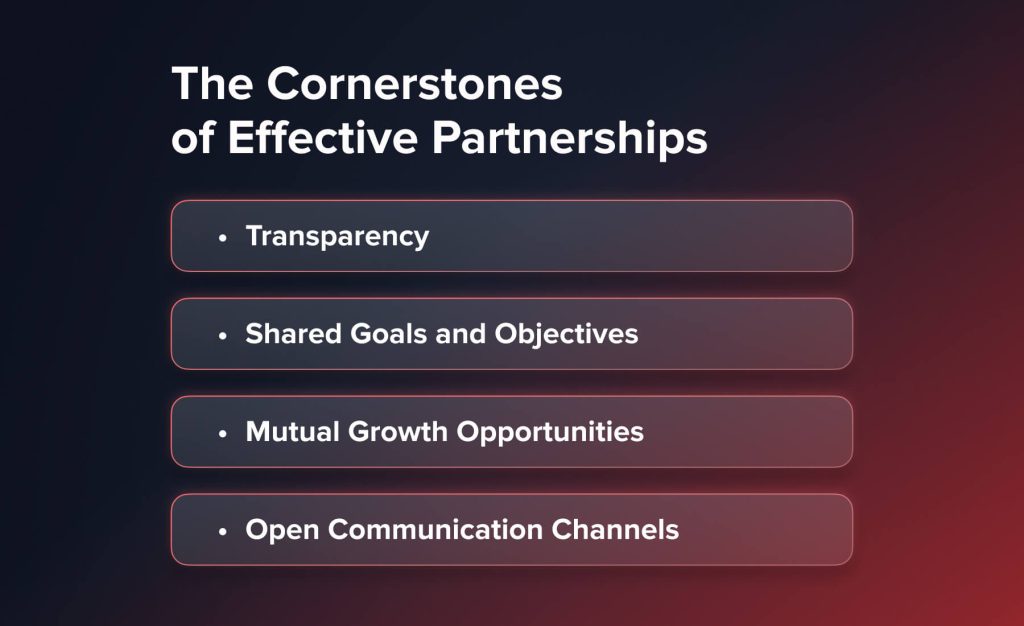
Creador de mercado vs proveedor de liquidez: ¿cuál es la diferencia?
Contenidos
La liquidez sigue siendo un pilar para la operación eficiente de los mercados en las corredoras de paisajes financieros que cambian rápidamente, los principales actores en estos mercados dependen de un conocimiento profundo de las empresas que apoyan la liquidez: fabricantes de mercado y Proveedores de liquidez . Recognizing their distinct rolesystrategies, especially for brokerage owners, is pivotal in designing a compliantyscalable modelo de negocio de corretaje . This article delves deep into these two pillars, highlighting their operations, advantages,ychallenges.
Comprender los fabricantes de mercado
En el mercado financiero, los fabricantes de mercado desempeñan roles de compras y vendedores. Su principal papel es proporcionar liquidez continua del mercado, por lo tanto, unir el desequilibrio de la demanda de suministro. Citar precios de oferta (comprar) y preguntar (vender) para un activo muestra su preparación para el comercio. Al garantizar que los activos sean constantemente accesibles para el comercio, independientemente de las circunstancias más generales del mercado, realizan un servicio vital.
Imagine un escenario en el que no haya suficientes vendedores para un activo en particular. En tal situación, un comerciante que desea comprar podría encontrar un desafío localizar a un vendedor adecuado. Aquí, el fabricante de mercado interviene, aceptando vender el activo. Por otro lado, con una demanda insuficiente, el fabricante de mercado compraría el activo. Se aseguran de que los comerciantes siempre tengan una contraparte para su acuerdo cambiando constantemente sus tarifas e inventario declarados dependiendo de la dinámica del mercado.
Beneficios para corredores de bolsa y negocios:

- Presentados reducidos:La brecha entre estos precios, el diferencial, atiende menos a los fabricantes de mercado que ofrecen constantemente tasas de oferta y solicitar. Especialmente para los comerciantes regulares, un diferencial más cercano podría hacer que el comercio sea más rentable.
- Garantía de liquidez:Los fabricantes de mercado proporcionan una red de seguridad, asegurando que siempre haya un comprador o vendedor en el otro extremo. Esto es particularmente crucial en los mercados menos líquidos o durante la alta volatilidad. Para las casas de bolsa, la liquidez consistente es una ventaja significativa, asegurando operaciones sin problemas y satisfacción del cliente, especialmente cuando se combina con robusto Broker CRM Sistemas que optimizan la gestión del cliente y el enrutamiento comercial.
- Precios predecibles:Con la presencia continua de los fabricantes de mercado, las fluctuaciones de precios tienden a ser menos abruptas. El flujo constante de citas de oferta y oferta puede conducir a precios más estables, lo cual es beneficioso para los comerciantes y, por extensión, con las casas de bolsa con las que comercian.
Desafíos y consideraciones:
- Conflicto de intereses potencial:Dado que los fabricantes de mercado se benefician del diferencial, podrían estar inclinados a manipular la oferta y pedirles precios para su beneficio. Este conflicto de intereses inherente a veces puede llevar a que los comerciantes obtengan precios ligeramente menos favorables.
- Impacto del mercado percibido:Existe la percepción de que debido a que los fabricantes de mercado pueden tomar el lado opuesto de una operación, podrían influir en los precios de los activos. Si bien su papel principal es proporcionar liquidez, los grandes fabricantes de mercado, debido a su gran volumen, pueden tener un impacto notable en la dirección del mercado.
- La transparencia es crucial:Para los corredores de bolsa, trabajar con los fabricantes de mercado requiere transparencia. Se debe divulgar cualquier posible conflicto de intereses y se debe informar a los clientes si la principal fuente de liquidez de un corretaje es un fabricante de mercado. Un canal de comunicación abierto asegura que la confianza permanezca intacta.
Comprender los proveedores de liquidez
La base de la negociación efectiva en los mercados financieros son proveedores de liquidez o LP. A diferencia de los fabricantes de mercado que construyen activamente un mercado citando los precios de compra y venta, los proveedores de liquidez generalmente suministran valores de activos dependiendo del estado del mercado. Su objetivo principal es proporcionar al mercado más complejidad para que se puedan cumplir grandes pedidos sin afectar significativamente los valores de los activos.
LPS, en virtud de sus expansivas reservas financieras, puede manejar transacciones considerables que de otro modo podrían desestabilizar mercados más pequeños. Los comerciantes utilizan la liquidez que estas compañías brindan para completar grandes transacciones, por lo tanto, garantizan un deslizamiento mínimo y el cumplimiento de la orden efectiva. Es una relación simbiótica: los comerciantes ganan desde la profundidad; Proveedores de ganancia de liquidez del volumen de negociación, especialmente en alta frecuencia comercio algorítmico entornos.
You may also like

Tipos de proveedores de liquidez e implicaciones:

- Bancos principales:Entre los bancos más grandes del mundo, incluidos Citibank, Goldman Sachs y JPMorgan, varios operan como principales proveedores de liquidez. Muchos corredores de bolsa los eligen debido a su gran liquidez dados sus grandes recursos financieros. Sin embargo, su escala a veces podría significar menos flexibilidad en las negociaciones contractuales.
- Instituciones financieras especializadas:Estas son empresas diseñadas específicamente para ofrecer liquidez del mercado. Si bien es posible que no coincidan con la escala de los principales bancos, pueden proporcionar ofertas más especializadas o de nicho, atendiendo segmentos específicos del mercado.
- Redes de comunicación electrónica (ECN):Actuando como un proveedor de liquidez virtual, estos algoritmos automatizados coinciden con las órdenes de compra y venta de activos. Desde ECNS Muestre los mejores precios de oferta disponible y solicite a muchos actores del mercado, pueden proporcionar más precios abiertos.
Ventajas para las operaciones comerciales:
- Spreads competitivos:La colaboración con múltiples LP permite a las casas de bolsa comprar los mejores precios, asegurando diferenciales más estrictos para su clientela. Esto es especialmente valioso para las casas de bolsa que atienden a comerciantes de alta frecuencia, donde incluso las mejoras menores de precios pueden afectar significativamente la rentabilidad.
- Ejecución comercial óptima:Con grupos de liquidez más profundos, los pedidos grandes se cumplen de manera más eficiente, minimizando el impacto adverso en los precios de los activos. Esto garantiza que incluso los clientes institucionales o aquellos que operan en grandes volúmenes experimentan un deslizamiento mínimo.
- Diversificación de riesgos:Comprometerse con varios LP ayuda a los corredores de bolsa a diversificar su riesgo operativo. En el improbable caso de un LP que enfrenta problemas, tener múltiples proveedores asegura que el comercio pueda continuar sin problemas.
- Atrayendo una base de clientes más amplia:Los clientes potenciales encontrarán una gran atracción en un grupo de liquidez bien organizado con precios competitivos y ejecución efectiva de pedidos, una característica clave para la oferta de corredores Cuentas comerciales administradas a individuos o instituciones de alto patrimonio. Muestra cuán dedicada es una corredora para proporcionar la mayor experiencia comercial posible.
Distinciones clave entre los fabricantes de mercado y los proveedores de liquidez
Los mundos de los fabricantes de mercado y los proveedores de liquidez a menudo se cruzan, pero operan con mecanismos y objetivos distintos. Para los propietarios de corretaje y los jefes de negocios, discernir sus diferencias es vital para la alineación estratégica y las operaciones eficientes.
Dinámica operativa:
- Fabricantes de mercado
Participan en el mercado activamente. Por su propia naturaleza, los fabricantes de mercado producen deliberadamente un mercado de dos lados. Garantizan que, independientemente de las circunstancias del mercado, siempre hay una contraparte lista para los comerciantes al citar los precios de compra y venta de un producto particular. Su modelo operativo gira en torno a facilitar el comercio continuo incluso en activos menos líquidos o en tiempos de estrés del mercado.
- Proveedores de liquidez
Su papel es más pasivo. En lugar de dictar precios, LPS ofrece activos basados en las tasas actuales del mercado. Mejoran la profundidad del mercado, asegurando que las operaciones se puedan ejecutar sin cambios de precios dramáticos, lo cual es especialmente importante para las operaciones considerables. Su enfoque está en llenar los pedidos en lugar de determinar el precio.
Influencia en los precios y ejecución de los activos:
- Fabricantes de mercado
Su influencia puede conducir a un precio más predecible, lo cual es especialmente beneficioso en los mercados donde la liquidez es esporádica. La cita de doble cara garantiza que los diferenciales sigan siendo más estrechos, proporcionando un entorno comercial más estable. Sin embargo, esto a veces podría significar que los comerciantes no siempre obtienen los precios más favorables, especialmente si el fabricante de mercado es la entidad dominante en una clase de activos particular.
- Proveedores de liquidez
En los mercados con muchos proveedores de liquidez, la competencia impulsa precios más favorables para los comerciantes. Su profundidad asegura que incluso las operaciones grandes se puedan ejecutar con un impacto mínimo en el precio. Esto es particularmente ventajoso en mercados altamente líquidos, donde el gran volumen de comercio y la presencia de múltiples LP pueden conducir a diferenciales muy competitivos.
Gestión de riesgos para corredores de bolsa:
- Fabricantes de mercado
Comprometerse principalmente con un fabricante de mercado único o limitado puede introducir un riesgo de contraparte específico. Si un fabricante de mercado descuida sus responsabilidades o se encuentra con problemas financieros, el comercio del medio ambiente puede verse perturbado. Para los corredores de bolsa, es crucial evaluar la situación financiera y la reputación de los fabricantes de mercado seleccionados.
- Proveedores de liquidez
La diversificación en múltiples LP puede mitigar significativamente los riesgos. Si un LP enfrenta desafíos, la presencia de proveedores alternativos asegura que la ejecución comercial no se vea afectada. Además, con múltiples entidades que compiten por los negocios, los corredores de bolsa a menudo pueden negociar mejores términos y precios.
Requisitos y compromiso de capital:
- Fabricantes de mercado
Por lo general, necesitan reservas de capital sustanciales. Dado su papel en citar activamente los precios de compra y venta, los fabricantes de mercado a menudo mantienen un capital significativo para gestionar los riesgos asociados con las posiciones de tenencia, especialmente en situaciones de mercado volátiles.
- Proveedores de liquidez
Los LP no necesariamente requieren la misma profundidad de reservas de capital que los fabricantes de mercado. Su función principal es facilitar las operaciones, lo que a menudo significa que compensan las posiciones con más frecuencia y pueden no mantenerlas durante períodos prolongados.
Papel en la estabilidad del mercado:
- Fabricantes de mercado
Al comprometerse a comprar y vender activos, a menudo actúan como una fuerza estabilizadora, especialmente en mercados de nicho o menos líquidos. Su presencia continua puede prevenir brechas bruscas del mercado y proporcionar una sensación de confiabilidad a otros participantes del mercado.
- Proveedores de liquidez
Si bien también contribuyen a la estabilidad del mercado, su impacto a menudo es más pronunciado en los mercados líquidos ampliamente cotizados. Al ofrecer profundidad, aseguran ejecuciones comerciales suaves, incluso durante los tiempos de negociación de alto volumen.
Naturaleza de las relaciones con corredores de bolsa:
- Fabricantes de mercado
Las relaciones a menudo están más estructuradas. Las casas de bolsa pueden tener acuerdos específicos que detallan los precios, los volúmenes y los términos de compromiso, asegurando un flujo predecible de operaciones.
- Proveedores de liquidez
Los compromisos tienden a ser más fluidos. Si bien puede haber acuerdos generales en su lugar, las interacciones cotidianas son impulsadas por la dinámica del mercado, con precios, volúmenes y diferenciales que se ajustan continuamente en función de las condiciones en tiempo real.
Interfaces tecnológicas e integración:
- Fabricantes de mercado
Dado su papel activo en las cotizaciones de precios, a menudo tienen interfaces tecnológicas sofisticadas, lo que permite la comunicación en tiempo real de los precios de oferta y solicitud. La integración con corredores de bolsa puede requerir soluciones tecnológicas personalizadas para garantizar un flujo de datos sin problemas.
- Proveedores de liquidez
Sus sistemas están diseñados para la velocidad y el volumen. El énfasis está en manejar eficientemente muchas solicitudes comerciales, a menudo de múltiples corredores de bolsa simultáneamente. La integración suele ser más directa, enfatizando la ejecución de orden rápida.
Para simplificar estas distinciones, aquí hay una comparación lado a lado de cómo operan los fabricantes de mercado y los proveedores de liquidez a través de las dimensiones clave
| Atributo | Creador de mercado | Proveedor de liquidez |
| Enfoque comercial | Mantener activamente los precios de compra y venta | Establecer la profundidad del mercado ofreciendo tasas de mercado en tiempo real |
| Influencia del precio | Estabilizar los precios en los mercados que carecen de liquidez | Competir para proporcionar diferenciales más estrictos a sus usuarios |
| Requisitos de capital | Requieren un capital sustancial para mantener el inventario y tener riesgo | Requiere capital moderado para completar las operaciones de manera eficiente |
| Riesgo de ejecución | Exposición centralizada y mayor de la contraparte | Descentralizado, extendido por múltiples proveedores |
| Integración tecnológica | Conectarse a través de sistemas API complejos para transmitir cotizaciones | Los sistemas de ejecución de alta velocidad permiten el procesamiento de volumen |
| Rol de estabilidad del mercado | Estabiliza durante la volatilidad o baja liquidez | Optimiza la ejecución durante los volúmenes máximos |
| Relación de corredor | Acuerdos estructurados con términos específicos | Interacciones dinámicas, impulsadas por el volumen |
Las casas de bolsa que entienden estas distinciones pueden igualar sus modelos de ejecución con socios adecuados para mejorar el rendimiento y la satisfacción del cliente.
Paisaje regulatorio y cumplimiento
El sector financiero depende en gran medida de las leyes y las medidas de cumplimiento. Seguir estas directrices ayuda a las casas de bolsa a mantener la credibilidad y garantizar la operación perfecta del ecosistema financiero cuando trabajan con fabricantes de mercado y proveedores de liquidez.
Las casas de bolsa operan en un entorno donde la confianza gobierna sobre todo. Ya sea que sean empresas institucionales o comerciantes individuales, los clientes que ponen su dinero en un corretaje quieren garantizar que sus inversiones sean seguras y que el corredor administra un negocio justo y abierto. El fuerte cumplimiento de las reglas regulatorias ayuda a desarrollar y fortalecer esta confianza.
Las políticas con respecto a los corredores de bolsa y sus interacciones con los fabricantes de mercado y los proveedores de liquidez varían según la nación y el área. Por ejemplo:
- Dentro de Europa, la Autoridad Europea de Valores y Mercados (ESMA) tiene estándares específicos que rigen los contratos de diferencias (CFD) y sus interacciones con los fabricantes de mercados.
- Para los EE. UU. Especialmente con respecto a la transparencia y los precios justos, la Comisión de Bolsa y Valores (SEC) y la Comisión de Comercio de Futuros de los productos básicos (CFTC) establecieron reglas.
- Con criterios de cumplimiento particulares, los países del Pacífico de Asia como Singapur y Hong Kong tienen sus propios cuerpos reguladores: la Comisión de Valores y Futuros (SFC) y la Autoridad Monetaria de Singapur (MAS).
Navegar por el laberinto regulatorio:
Dada la diversidad de los organismos regulatorios y sus directrices, los corredores de bolsa deben:
- Mantente informado:Actualizarse regularmente sobre cualquier cambio regulatorio, principalmente si operan en múltiples jurisdicciones. Es crucial tener un equipo o asesor de cumplimiento dedicado familiarizado con las regulaciones locales.
- Asegurar la transparencia:Los corredores de bolsa deben mantener registros precisos de todas las transacciones, especialmente aquellas que involucran a fabricantes de mercado y proveedores de liquidez. Estos registros deben ser fácilmente accesibles para auditorías o inspecciones regulatorias.
- Construir relaciones:Tener canales de comunicación abiertos con reguladores puede ser invaluable. Participar en diálogos regulares, asistir a seminarios de la industria o participar en rondas de consulta puede dar a las correctores una perspectiva más clara sobre las expectativas regulatorias y las tendencias emergentes.
Conocer la escena regulatoria no se trata solo de evitar multas; También es una necesidad estratégica de propietarios de corredores de bolsa. Al armonizar las operaciones con las regulaciones, la posición de la corredora puede mejorar y se atraerán a los clientes y socios más selectivos. También puede evitar interrupciones costosas resultantes de violaciones legales.
Control de llave
- Los fabricantes de mercado crean activamente y garantizan liquidez con los precios de compra y venta, mientras que los proveedores de liquidez proporcionan profundidad y permiten transacciones más grandes sin afectar apreciablemente los precios de los activos.
- Los proveedores de liquidez proporcionan precios competitivos en los mercados líquidos, los fabricantes de mercado garantizan el comercio constante con precios estables.
- Si bien los fabricantes de mercado ayudan activamente a determinar los precios, los proveedores de liquidez responden a las condiciones actuales del mercado pasivamente.
Forjar asociaciones y colaboraciones efectivas
Los hilos en el intrincado tejido del ecosistema financiero, las asociaciones y las alianzas vinculan las instituciones para aumentar su poder y alcance combinados. Ya sea con fabricantes de mercado o proveedores de liquidez, estas relaciones son asociaciones estratégicas que podrían determinar el éxito futuro de una corredora.
Las piedras angulares de las asociaciones efectivas:

- Transparencia:La transparencia es la base de cualquier asociación sólida en el mundo financiero. Ambas partes deben tener una visibilidad clara sobre los términos de la asociación, los procesos operativos y cualquier desafío potencial. Herramientas como paneles compartidos o informes de rendimiento regulares pueden fomentar la transparencia, asegurando que ambas partes permanezcan alineadas.
- Objetivos y objetivos compartidos:Una asociación necesita alineación de los intereses si se va a florecer. Esto implica que ambas partes tienen los mismos objetivos y visión de dónde quieren que vaya la cooperación. Esta alineación se puede fomentar a través de sesiones de estrategia regulares y diálogos abiertos sobre tendencias del mercado, desafíos y oportunidades.
- Oportunidades de crecimiento mutuo:Trabajar juntos no debería ser un juego de suma cero. Las colaboraciones ideales son las que la expansión para un lado da como resultado la expansión para el otro. Para las casas de bolsa, esto podría significar acceso a una mejor liquidez o términos más favorables. Para los fabricantes de mercado o los proveedores de liquidez, podría traducirse en una base de clientes más amplia o un aumento de los volúmenes comerciales, especialmente cuando se integran con plataformas de corretaje de etiquetas blancas que permiten una escala rápida.
- Canales de comunicación abiertos:El panorama financiero es dinámico, con condiciones del mercado y pautas regulatorias que constantemente evolucionan. Por lo tanto, es crucial mantener canales abiertos de comunicación. Los registros regulares, las sesiones de retroalimentación y los programas de capacitación conjunta pueden garantizar que ambas partes estén en la misma página y puedan adaptarse rápidamente a los escenarios cambiantes.
Para las casas de bolsa que analizan el desarrollo y la estabilidad a largo plazo, las colaboraciones estratégicas con los fabricantes de mercado o los proveedores de liquidez podrían resultar transformadoras. Sin embargo, estas relaciones no deben verse como fijas. Son entidades dinámicas que deben ser fomentadas, evaluadas y refinadas para asegurarse de que se mantengan mutuamente beneficiosas en un entorno financiero siempre cambiante. Los corredores de bolsa pueden maximizar las posibilidades reales de estas asociaciones al estresar la apertura, el desarrollo colaborativo y la evaluación continua, lo que las lleva hacia un éxito constante.
Conclusión
Los corredores modernos deben negociar los complejos mundos de los fabricantes de mercado y los proveedores de liquidez. Las casas de bolsa pueden tomar decisiones educadas conociendo sus deberes, beneficios y posibles riesgos, por lo tanto, garantizar el desarrollo sostenible y generar confianza del cliente en la escena financiera siempre cambiante.
Glosario de términos clave
BID-ASK SPRIGHT
Es representa la diferencia entre lo que los compradores quieren pagar (precio de la oferta) y lo que los vendedores exigen (precio de consulta). Una extensión más pequeña o más estricta a menudo se asocia con un mercado líquido y un menor costo de comercio.
Deslizamiento
La diferencia entre lo que puede comprar o vender un activo. Común en tiempos de alta volatilidad o baja liquidez.
Libro A
Un modelo de corretaje donde los pedidos del cliente se enrutan directamente a proveedores de liquidez externos. El corredor se beneficia de spreads o comisiones sin involucrar a su propio capital en riesgo.
B-Book
Un modelo en el que el corredor ejecuta operaciones a través de su propio capital, cotizando efectivamente contra los clientes. Generalmente combinado con los compromisos de estrategias de fabricación de mercado.
FAQ
Un fabricante de mercado cita compra y vende precios en todo momento, comprando cuando desea vender y vender cuando otros quieren comprar, asegurando el comercio continuo y los diferenciales más estrictos. Por el contrario, un proveedor de liquidez proporciona pasivamente la profundidad del mercado en forma de flujos de precios constantes que reflejan la demanda en tiempo real y no compiten con un comprador o vendedor; En su lugar, proporcionan un servicio de ejecución de pedidos (es decir, establecer precios).
Sí. Ciertos grandes jugadores también se convierten en fabricantes de mercado y proveedores de liquidez, especialmente en condiciones comerciales de activos múltiples o híbridos de los modelos de corretaje. Este último admite una mayor liquidez de ejecución y les permite controlar los diferenciales.
Se basa en el modelo de negocio de corretaje. Esta es la razón por la cual a los corredores de B-Book les gustaría trabajar con los fabricantes de mercado para mantener las operaciones internas e intentar administrar los diferenciales. El uso de A-Book le permite conectarse a muchos LP, lo que nuevamente permite diferenciales más ajustados, menos deslizamiento y una mejor calidad de ejecución. En realidad, la mayoría de los corredores usan una mezcla de los dos para tener un equilibrio entre el riesgo y el rendimiento.
Sí, especialmente proveedores de liquidez de nivel 1. La supervisión regulatoria varía según la región: ESMA en la UE; CFTC y SEC en los Estados Unidos; FCA en el Reino Unido; Mas en Singapur; SFC en Hong Kong. Los corredores que trabajan con LPS deben garantizar que estos socios cumplan con los estándares de cumplimiento y transparencia relevantes.
Actualizado:
8 de agosto de 2025



